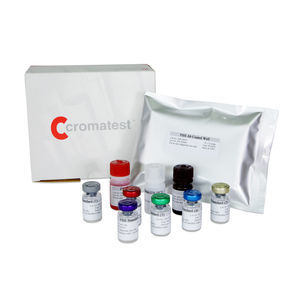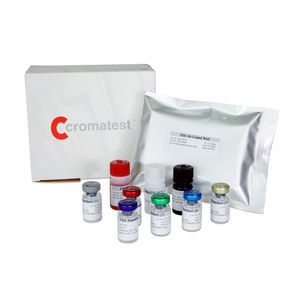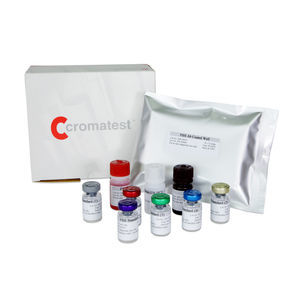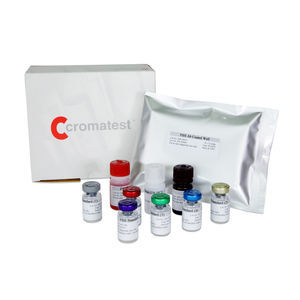
- Laboratory
- Laboratory medicine
- Solution reagent
- LINEAR CHEMICALS
Solution reagent kit 6107225diagnosticTSH
Add to favorites
Compare this product
Characteristics
- Type
- solution
- Applications
- diagnostic
- Tested parameter
- TSH
- Storage temperature
Max.: 8 °C
(46 °F)Min.: 2 °C
(36 °F)
Description
The determination of serum or plasma levels of thyroid stimulating hormone (TSH or thyrotropin) is recognized as a sensitive method in the diagnosis of primary and secondary hypothyroidism.1 TSH is secreted by the anterior lobe of the pituitary gland and induces the production and release of thyroxine and triiodothyronine from the thyroid gland.2 It is a glycoprotein with a molecular weight of approximately 28,000 daltons, consisting of two chemically different subunits, alpha and beta.3
Although the concentration of TSH in the blood is extremely low, it is essential for the maintenance of normal thyroid function. The release of TSH is regulated by a TSH-releasing hormone (TRH) produced by the hypothalamus. The levels of TSH and TRH are inversely related to the level of thyroid hormone. When there is a high level of thyroid hormone in the blood, less TRH is released by the hypothalamus, so less TSH is secreted by the pituitary. The opposite action will occur when there is decreased thyroid hormone in the blood. This process is known as a negative feedback mechanism and is responsible for maintaining the proper blood levels of these hormones.
TSH and the pituitary glycoproteins: luteinizing hormone (LH), follicle-stimulating hormone (FSH), and human chorionic gonadotropin (hCG), have identical alpha chains. The beta chains are distinct but do contain regions with identical amino acid sequences. These regions of homology can cause considerable cross-reactivity with some polyclonal TSH antisera.
Catalogs
No catalogs are available for this product.
See all of LINEAR CHEMICALS‘s catalogsRelated Searches
- Assay kit
- LiNEAR solution reagent
- Blood assay kit
- LiNEAR molecular biology reagent
- Immunoassay assay kit
- Plasma assay kit
- Infectious disease detection kit
- LiNEAR rapid blood test
- LiNEAR diagnostic reagent
- LiNEAR protein reagent
- Rapid lateral flow test
- LiNEAR laboratory reagent
- Immunoassay rapid diagnostic test
- LiNEAR cassette rapid test
- LiNEAR rapid virus test
- LiNEAR rapid serum test
- LiNEAR rapid plasma test
- Histology reagent kit
- LiNEAR medium reagent
- LiNEAR rapid infectious disease test
*Prices are pre-tax. They exclude delivery charges and customs duties and do not include additional charges for installation or activation options. Prices are indicative only and may vary by country, with changes to the cost of raw materials and exchange rates.














